Accounting Theory: Conceptual Framework, IFRS, and Reporting Analysis
VerifiedAdded on 2021/02/22
|18
|5052
|61
Report
AI Summary
This report provides an executive summary and detailed analysis of contemporary accounting theory, focusing on the conceptual framework for financial reporting. It explores the history and development of the framework in the UK, USA, Australia, and globally under IASB, addressing Australian accounting profession's concerns regarding IFRS implementation. The report critically discusses the quality of the conceptual framework, its application in Rio Tinto Ltd, and compares sustainability reporting guidelines of GRI and IIRC. It examines the strengths and limitations of conventional accounting, theories applicable to sustainability and integrated reports, and includes a checklist for integrated report components, comparing Australian and South African corporate social reporting. The report concludes with a comprehensive overview of the subject matter, referencing relevant literature and providing valuable insights into the practical application of accounting principles.
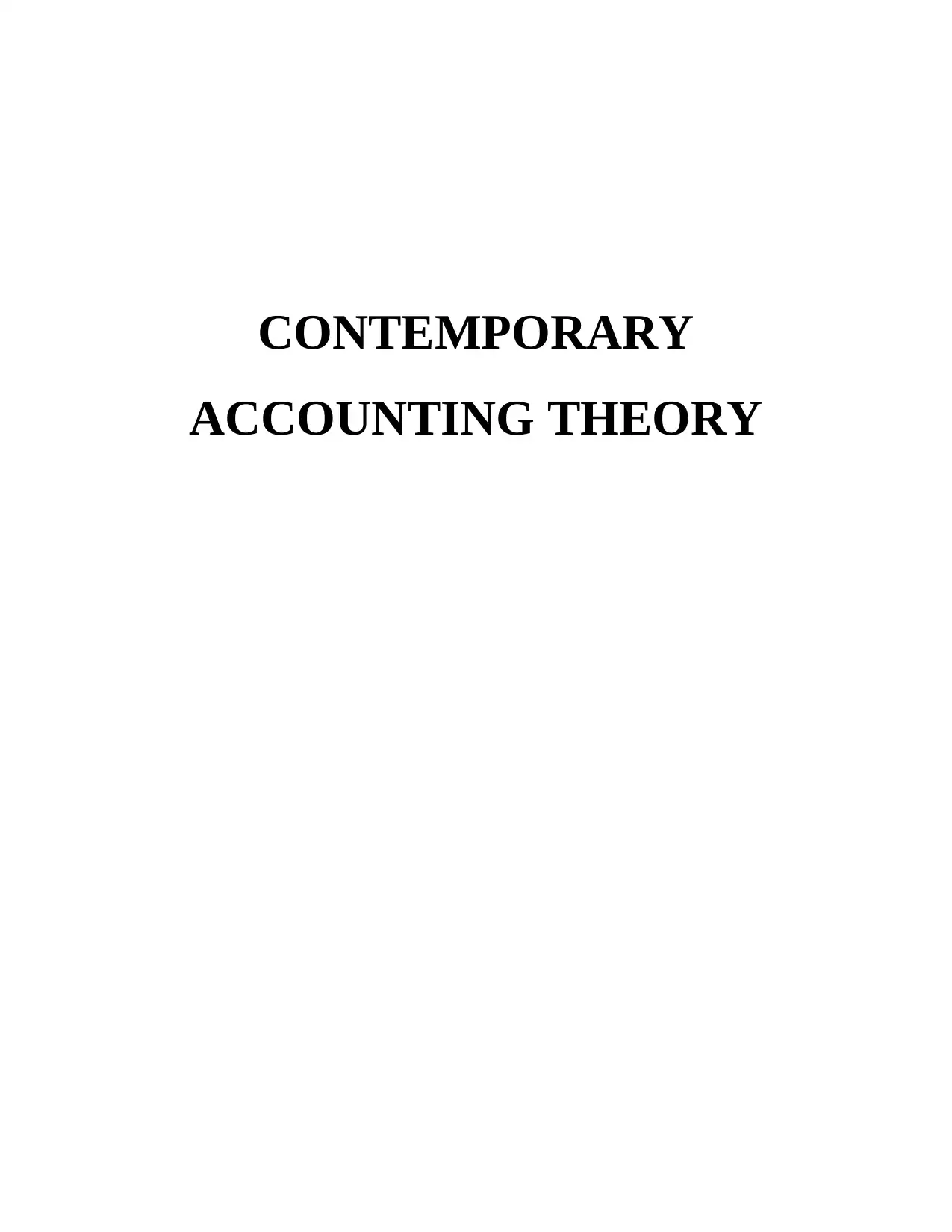
CONTEMPORARY
ACCOUNTING THEORY
ACCOUNTING THEORY
Paraphrase This Document
Need a fresh take? Get an instant paraphrase of this document with our AI Paraphraser
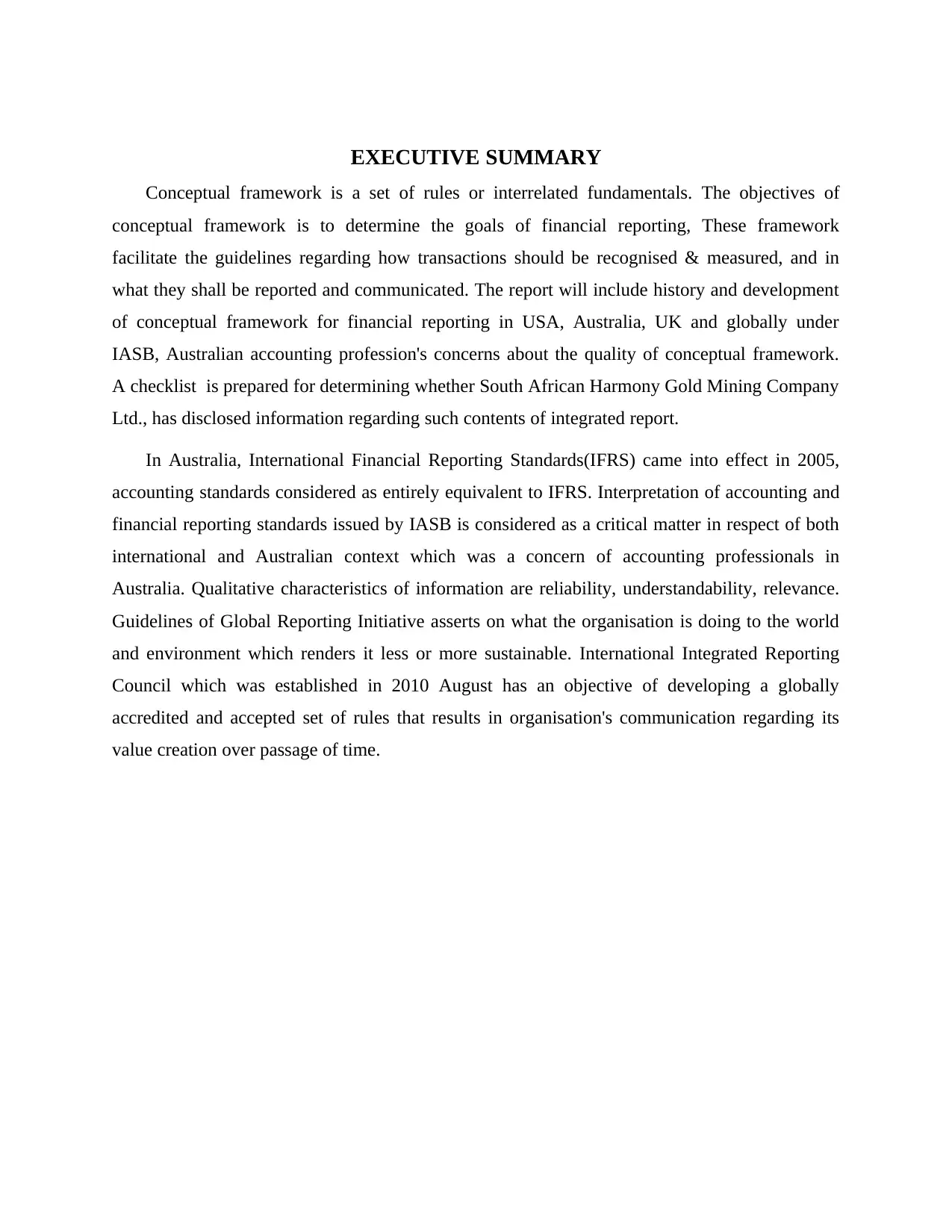
EXECUTIVE SUMMARY
Conceptual framework is a set of rules or interrelated fundamentals. The objectives of
conceptual framework is to determine the goals of financial reporting, These framework
facilitate the guidelines regarding how transactions should be recognised & measured, and in
what they shall be reported and communicated. The report will include history and development
of conceptual framework for financial reporting in USA, Australia, UK and globally under
IASB, Australian accounting profession's concerns about the quality of conceptual framework.
A checklist is prepared for determining whether South African Harmony Gold Mining Company
Ltd., has disclosed information regarding such contents of integrated report.
In Australia, International Financial Reporting Standards(IFRS) came into effect in 2005,
accounting standards considered as entirely equivalent to IFRS. Interpretation of accounting and
financial reporting standards issued by IASB is considered as a critical matter in respect of both
international and Australian context which was a concern of accounting professionals in
Australia. Qualitative characteristics of information are reliability, understandability, relevance.
Guidelines of Global Reporting Initiative asserts on what the organisation is doing to the world
and environment which renders it less or more sustainable. International Integrated Reporting
Council which was established in 2010 August has an objective of developing a globally
accredited and accepted set of rules that results in organisation's communication regarding its
value creation over passage of time.
Conceptual framework is a set of rules or interrelated fundamentals. The objectives of
conceptual framework is to determine the goals of financial reporting, These framework
facilitate the guidelines regarding how transactions should be recognised & measured, and in
what they shall be reported and communicated. The report will include history and development
of conceptual framework for financial reporting in USA, Australia, UK and globally under
IASB, Australian accounting profession's concerns about the quality of conceptual framework.
A checklist is prepared for determining whether South African Harmony Gold Mining Company
Ltd., has disclosed information regarding such contents of integrated report.
In Australia, International Financial Reporting Standards(IFRS) came into effect in 2005,
accounting standards considered as entirely equivalent to IFRS. Interpretation of accounting and
financial reporting standards issued by IASB is considered as a critical matter in respect of both
international and Australian context which was a concern of accounting professionals in
Australia. Qualitative characteristics of information are reliability, understandability, relevance.
Guidelines of Global Reporting Initiative asserts on what the organisation is doing to the world
and environment which renders it less or more sustainable. International Integrated Reporting
Council which was established in 2010 August has an objective of developing a globally
accredited and accepted set of rules that results in organisation's communication regarding its
value creation over passage of time.
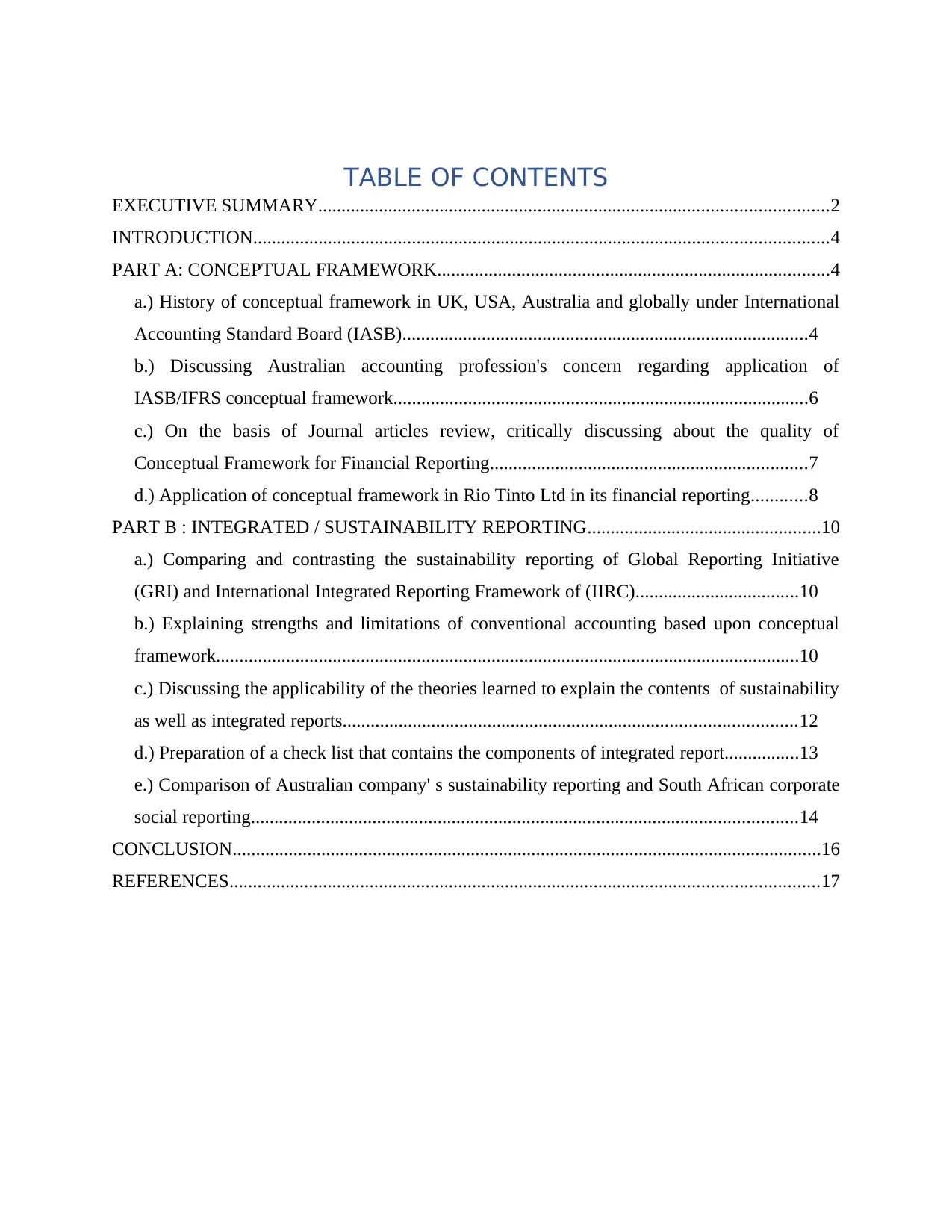
TABLE OF CONTENTS
EXECUTIVE SUMMARY.............................................................................................................2
INTRODUCTION...........................................................................................................................4
PART A: CONCEPTUAL FRAMEWORK....................................................................................4
a.) History of conceptual framework in UK, USA, Australia and globally under International
Accounting Standard Board (IASB).......................................................................................4
b.) Discussing Australian accounting profession's concern regarding application of
IASB/IFRS conceptual framework.........................................................................................6
c.) On the basis of Journal articles review, critically discussing about the quality of
Conceptual Framework for Financial Reporting....................................................................7
d.) Application of conceptual framework in Rio Tinto Ltd in its financial reporting............8
PART B : INTEGRATED / SUSTAINABILITY REPORTING..................................................10
a.) Comparing and contrasting the sustainability reporting of Global Reporting Initiative
(GRI) and International Integrated Reporting Framework of (IIRC)...................................10
b.) Explaining strengths and limitations of conventional accounting based upon conceptual
framework.............................................................................................................................10
c.) Discussing the applicability of the theories learned to explain the contents of sustainability
as well as integrated reports.................................................................................................12
d.) Preparation of a check list that contains the components of integrated report................13
e.) Comparison of Australian company' s sustainability reporting and South African corporate
social reporting.....................................................................................................................14
CONCLUSION..............................................................................................................................16
REFERENCES..............................................................................................................................17
EXECUTIVE SUMMARY.............................................................................................................2
INTRODUCTION...........................................................................................................................4
PART A: CONCEPTUAL FRAMEWORK....................................................................................4
a.) History of conceptual framework in UK, USA, Australia and globally under International
Accounting Standard Board (IASB).......................................................................................4
b.) Discussing Australian accounting profession's concern regarding application of
IASB/IFRS conceptual framework.........................................................................................6
c.) On the basis of Journal articles review, critically discussing about the quality of
Conceptual Framework for Financial Reporting....................................................................7
d.) Application of conceptual framework in Rio Tinto Ltd in its financial reporting............8
PART B : INTEGRATED / SUSTAINABILITY REPORTING..................................................10
a.) Comparing and contrasting the sustainability reporting of Global Reporting Initiative
(GRI) and International Integrated Reporting Framework of (IIRC)...................................10
b.) Explaining strengths and limitations of conventional accounting based upon conceptual
framework.............................................................................................................................10
c.) Discussing the applicability of the theories learned to explain the contents of sustainability
as well as integrated reports.................................................................................................12
d.) Preparation of a check list that contains the components of integrated report................13
e.) Comparison of Australian company' s sustainability reporting and South African corporate
social reporting.....................................................................................................................14
CONCLUSION..............................................................................................................................16
REFERENCES..............................................................................................................................17
⊘ This is a preview!⊘
Do you want full access?
Subscribe today to unlock all pages.

Trusted by 1+ million students worldwide
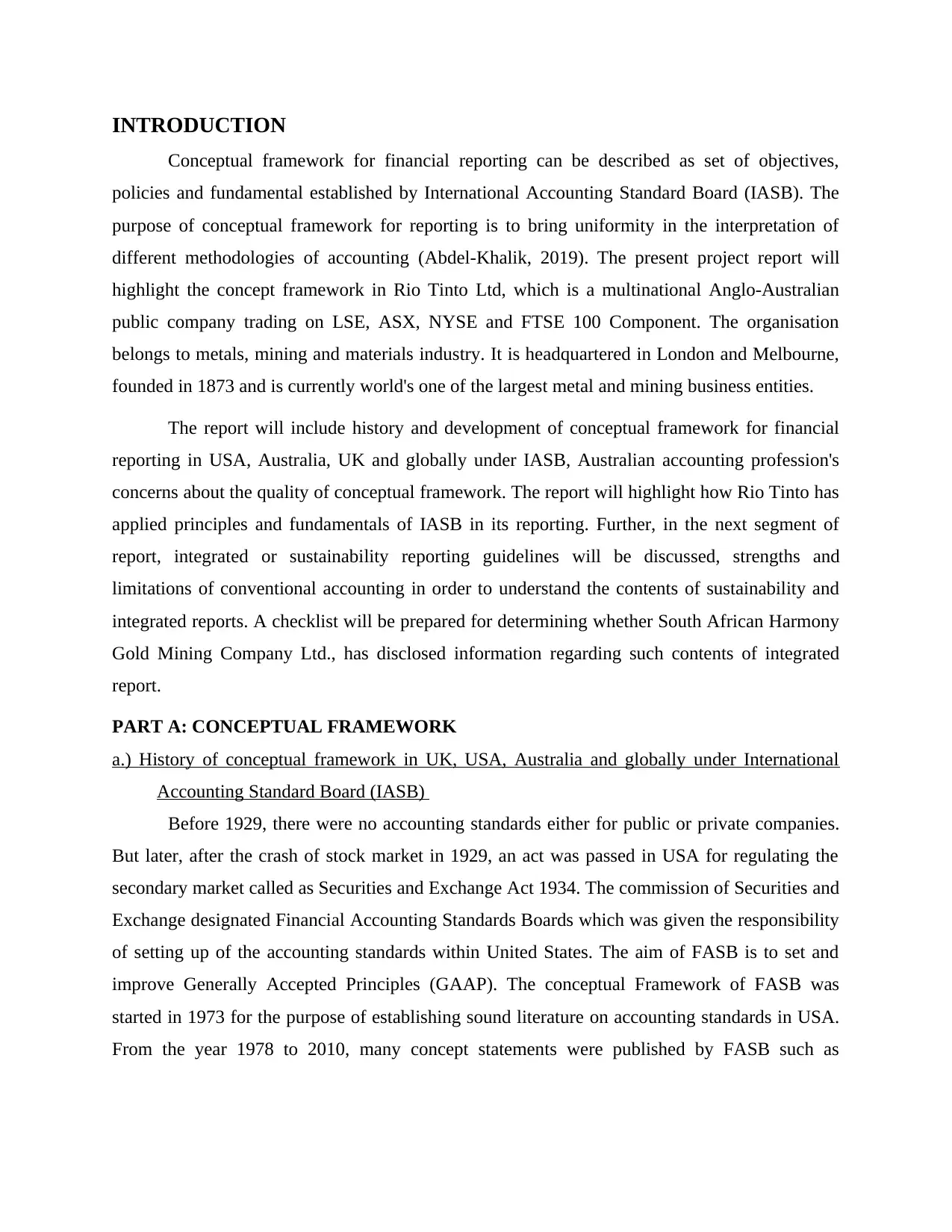
INTRODUCTION
Conceptual framework for financial reporting can be described as set of objectives,
policies and fundamental established by International Accounting Standard Board (IASB). The
purpose of conceptual framework for reporting is to bring uniformity in the interpretation of
different methodologies of accounting (Abdel-Khalik, 2019). The present project report will
highlight the concept framework in Rio Tinto Ltd, which is a multinational Anglo-Australian
public company trading on LSE, ASX, NYSE and FTSE 100 Component. The organisation
belongs to metals, mining and materials industry. It is headquartered in London and Melbourne,
founded in 1873 and is currently world's one of the largest metal and mining business entities.
The report will include history and development of conceptual framework for financial
reporting in USA, Australia, UK and globally under IASB, Australian accounting profession's
concerns about the quality of conceptual framework. The report will highlight how Rio Tinto has
applied principles and fundamentals of IASB in its reporting. Further, in the next segment of
report, integrated or sustainability reporting guidelines will be discussed, strengths and
limitations of conventional accounting in order to understand the contents of sustainability and
integrated reports. A checklist will be prepared for determining whether South African Harmony
Gold Mining Company Ltd., has disclosed information regarding such contents of integrated
report.
PART A: CONCEPTUAL FRAMEWORK
a.) History of conceptual framework in UK, USA, Australia and globally under International
Accounting Standard Board (IASB)
Before 1929, there were no accounting standards either for public or private companies.
But later, after the crash of stock market in 1929, an act was passed in USA for regulating the
secondary market called as Securities and Exchange Act 1934. The commission of Securities and
Exchange designated Financial Accounting Standards Boards which was given the responsibility
of setting up of the accounting standards within United States. The aim of FASB is to set and
improve Generally Accepted Principles (GAAP). The conceptual Framework of FASB was
started in 1973 for the purpose of establishing sound literature on accounting standards in USA.
From the year 1978 to 2010, many concept statements were published by FASB such as
Conceptual framework for financial reporting can be described as set of objectives,
policies and fundamental established by International Accounting Standard Board (IASB). The
purpose of conceptual framework for reporting is to bring uniformity in the interpretation of
different methodologies of accounting (Abdel-Khalik, 2019). The present project report will
highlight the concept framework in Rio Tinto Ltd, which is a multinational Anglo-Australian
public company trading on LSE, ASX, NYSE and FTSE 100 Component. The organisation
belongs to metals, mining and materials industry. It is headquartered in London and Melbourne,
founded in 1873 and is currently world's one of the largest metal and mining business entities.
The report will include history and development of conceptual framework for financial
reporting in USA, Australia, UK and globally under IASB, Australian accounting profession's
concerns about the quality of conceptual framework. The report will highlight how Rio Tinto has
applied principles and fundamentals of IASB in its reporting. Further, in the next segment of
report, integrated or sustainability reporting guidelines will be discussed, strengths and
limitations of conventional accounting in order to understand the contents of sustainability and
integrated reports. A checklist will be prepared for determining whether South African Harmony
Gold Mining Company Ltd., has disclosed information regarding such contents of integrated
report.
PART A: CONCEPTUAL FRAMEWORK
a.) History of conceptual framework in UK, USA, Australia and globally under International
Accounting Standard Board (IASB)
Before 1929, there were no accounting standards either for public or private companies.
But later, after the crash of stock market in 1929, an act was passed in USA for regulating the
secondary market called as Securities and Exchange Act 1934. The commission of Securities and
Exchange designated Financial Accounting Standards Boards which was given the responsibility
of setting up of the accounting standards within United States. The aim of FASB is to set and
improve Generally Accepted Principles (GAAP). The conceptual Framework of FASB was
started in 1973 for the purpose of establishing sound literature on accounting standards in USA.
From the year 1978 to 2010, many concept statements were published by FASB such as
Paraphrase This Document
Need a fresh take? Get an instant paraphrase of this document with our AI Paraphraser
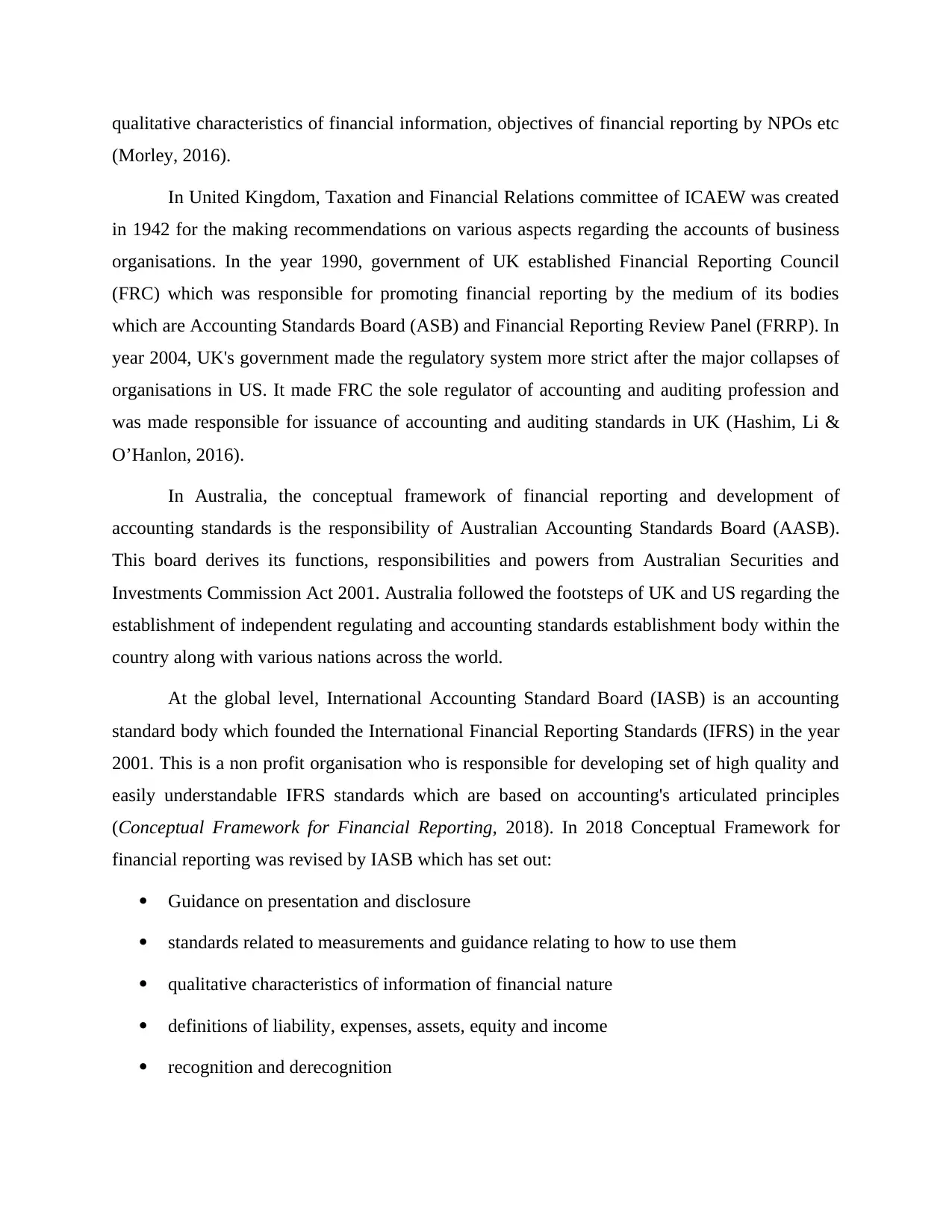
qualitative characteristics of financial information, objectives of financial reporting by NPOs etc
(Morley, 2016).
In United Kingdom, Taxation and Financial Relations committee of ICAEW was created
in 1942 for the making recommendations on various aspects regarding the accounts of business
organisations. In the year 1990, government of UK established Financial Reporting Council
(FRC) which was responsible for promoting financial reporting by the medium of its bodies
which are Accounting Standards Board (ASB) and Financial Reporting Review Panel (FRRP). In
year 2004, UK's government made the regulatory system more strict after the major collapses of
organisations in US. It made FRC the sole regulator of accounting and auditing profession and
was made responsible for issuance of accounting and auditing standards in UK (Hashim, Li &
O’Hanlon, 2016).
In Australia, the conceptual framework of financial reporting and development of
accounting standards is the responsibility of Australian Accounting Standards Board (AASB).
This board derives its functions, responsibilities and powers from Australian Securities and
Investments Commission Act 2001. Australia followed the footsteps of UK and US regarding the
establishment of independent regulating and accounting standards establishment body within the
country along with various nations across the world.
At the global level, International Accounting Standard Board (IASB) is an accounting
standard body which founded the International Financial Reporting Standards (IFRS) in the year
2001. This is a non profit organisation who is responsible for developing set of high quality and
easily understandable IFRS standards which are based on accounting's articulated principles
(Conceptual Framework for Financial Reporting, 2018). In 2018 Conceptual Framework for
financial reporting was revised by IASB which has set out:
Guidance on presentation and disclosure
standards related to measurements and guidance relating to how to use them
qualitative characteristics of information of financial nature
definitions of liability, expenses, assets, equity and income
recognition and derecognition
(Morley, 2016).
In United Kingdom, Taxation and Financial Relations committee of ICAEW was created
in 1942 for the making recommendations on various aspects regarding the accounts of business
organisations. In the year 1990, government of UK established Financial Reporting Council
(FRC) which was responsible for promoting financial reporting by the medium of its bodies
which are Accounting Standards Board (ASB) and Financial Reporting Review Panel (FRRP). In
year 2004, UK's government made the regulatory system more strict after the major collapses of
organisations in US. It made FRC the sole regulator of accounting and auditing profession and
was made responsible for issuance of accounting and auditing standards in UK (Hashim, Li &
O’Hanlon, 2016).
In Australia, the conceptual framework of financial reporting and development of
accounting standards is the responsibility of Australian Accounting Standards Board (AASB).
This board derives its functions, responsibilities and powers from Australian Securities and
Investments Commission Act 2001. Australia followed the footsteps of UK and US regarding the
establishment of independent regulating and accounting standards establishment body within the
country along with various nations across the world.
At the global level, International Accounting Standard Board (IASB) is an accounting
standard body which founded the International Financial Reporting Standards (IFRS) in the year
2001. This is a non profit organisation who is responsible for developing set of high quality and
easily understandable IFRS standards which are based on accounting's articulated principles
(Conceptual Framework for Financial Reporting, 2018). In 2018 Conceptual Framework for
financial reporting was revised by IASB which has set out:
Guidance on presentation and disclosure
standards related to measurements and guidance relating to how to use them
qualitative characteristics of information of financial nature
definitions of liability, expenses, assets, equity and income
recognition and derecognition
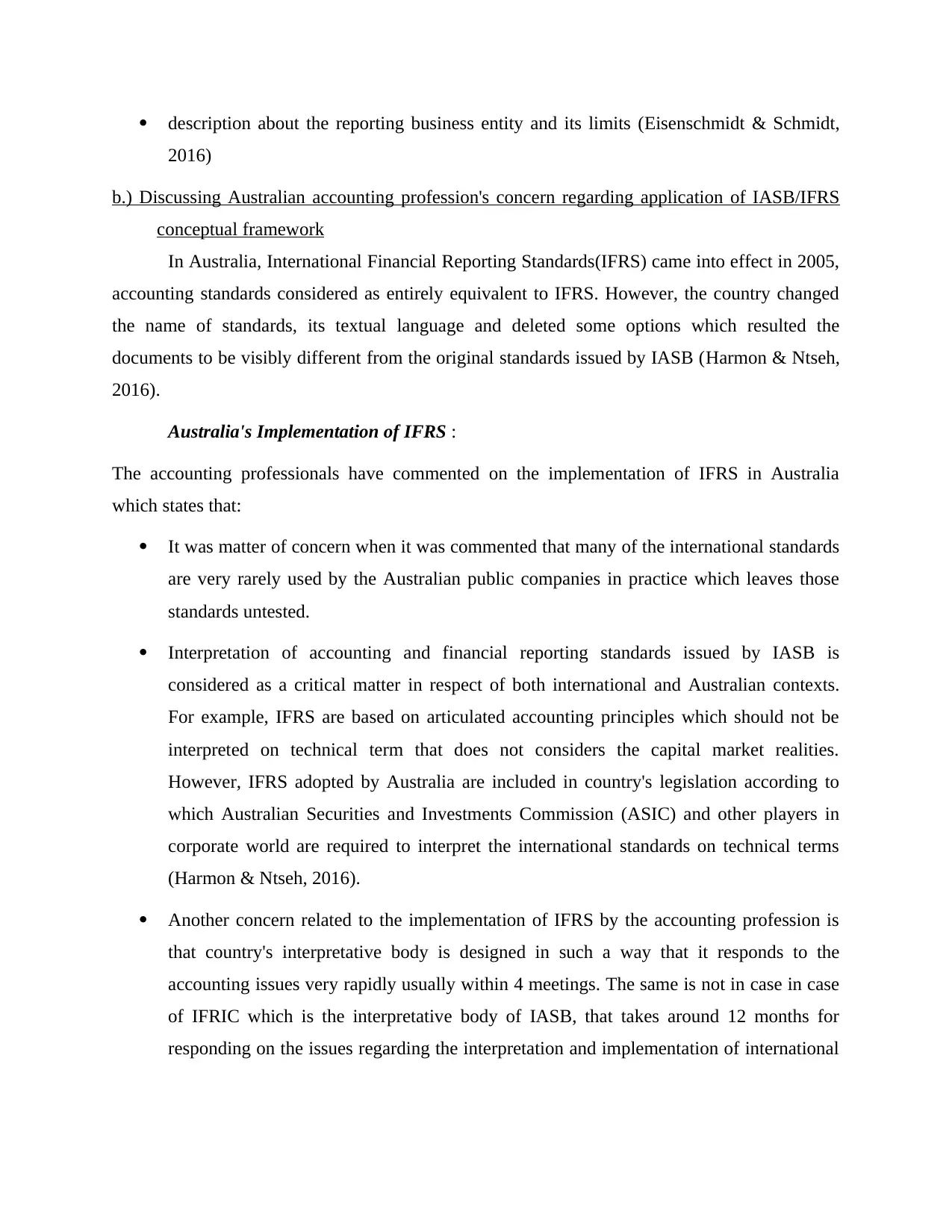
description about the reporting business entity and its limits (Eisenschmidt & Schmidt,
2016)
b.) Discussing Australian accounting profession's concern regarding application of IASB/IFRS
conceptual framework
In Australia, International Financial Reporting Standards(IFRS) came into effect in 2005,
accounting standards considered as entirely equivalent to IFRS. However, the country changed
the name of standards, its textual language and deleted some options which resulted the
documents to be visibly different from the original standards issued by IASB (Harmon & Ntseh,
2016).
Australia's Implementation of IFRS :
The accounting professionals have commented on the implementation of IFRS in Australia
which states that:
It was matter of concern when it was commented that many of the international standards
are very rarely used by the Australian public companies in practice which leaves those
standards untested.
Interpretation of accounting and financial reporting standards issued by IASB is
considered as a critical matter in respect of both international and Australian contexts.
For example, IFRS are based on articulated accounting principles which should not be
interpreted on technical term that does not considers the capital market realities.
However, IFRS adopted by Australia are included in country's legislation according to
which Australian Securities and Investments Commission (ASIC) and other players in
corporate world are required to interpret the international standards on technical terms
(Harmon & Ntseh, 2016).
Another concern related to the implementation of IFRS by the accounting profession is
that country's interpretative body is designed in such a way that it responds to the
accounting issues very rapidly usually within 4 meetings. The same is not in case in case
of IFRIC which is the interpretative body of IASB, that takes around 12 months for
responding on the issues regarding the interpretation and implementation of international
2016)
b.) Discussing Australian accounting profession's concern regarding application of IASB/IFRS
conceptual framework
In Australia, International Financial Reporting Standards(IFRS) came into effect in 2005,
accounting standards considered as entirely equivalent to IFRS. However, the country changed
the name of standards, its textual language and deleted some options which resulted the
documents to be visibly different from the original standards issued by IASB (Harmon & Ntseh,
2016).
Australia's Implementation of IFRS :
The accounting professionals have commented on the implementation of IFRS in Australia
which states that:
It was matter of concern when it was commented that many of the international standards
are very rarely used by the Australian public companies in practice which leaves those
standards untested.
Interpretation of accounting and financial reporting standards issued by IASB is
considered as a critical matter in respect of both international and Australian contexts.
For example, IFRS are based on articulated accounting principles which should not be
interpreted on technical term that does not considers the capital market realities.
However, IFRS adopted by Australia are included in country's legislation according to
which Australian Securities and Investments Commission (ASIC) and other players in
corporate world are required to interpret the international standards on technical terms
(Harmon & Ntseh, 2016).
Another concern related to the implementation of IFRS by the accounting profession is
that country's interpretative body is designed in such a way that it responds to the
accounting issues very rapidly usually within 4 meetings. The same is not in case in case
of IFRIC which is the interpretative body of IASB, that takes around 12 months for
responding on the issues regarding the interpretation and implementation of international
⊘ This is a preview!⊘
Do you want full access?
Subscribe today to unlock all pages.

Trusted by 1+ million students worldwide
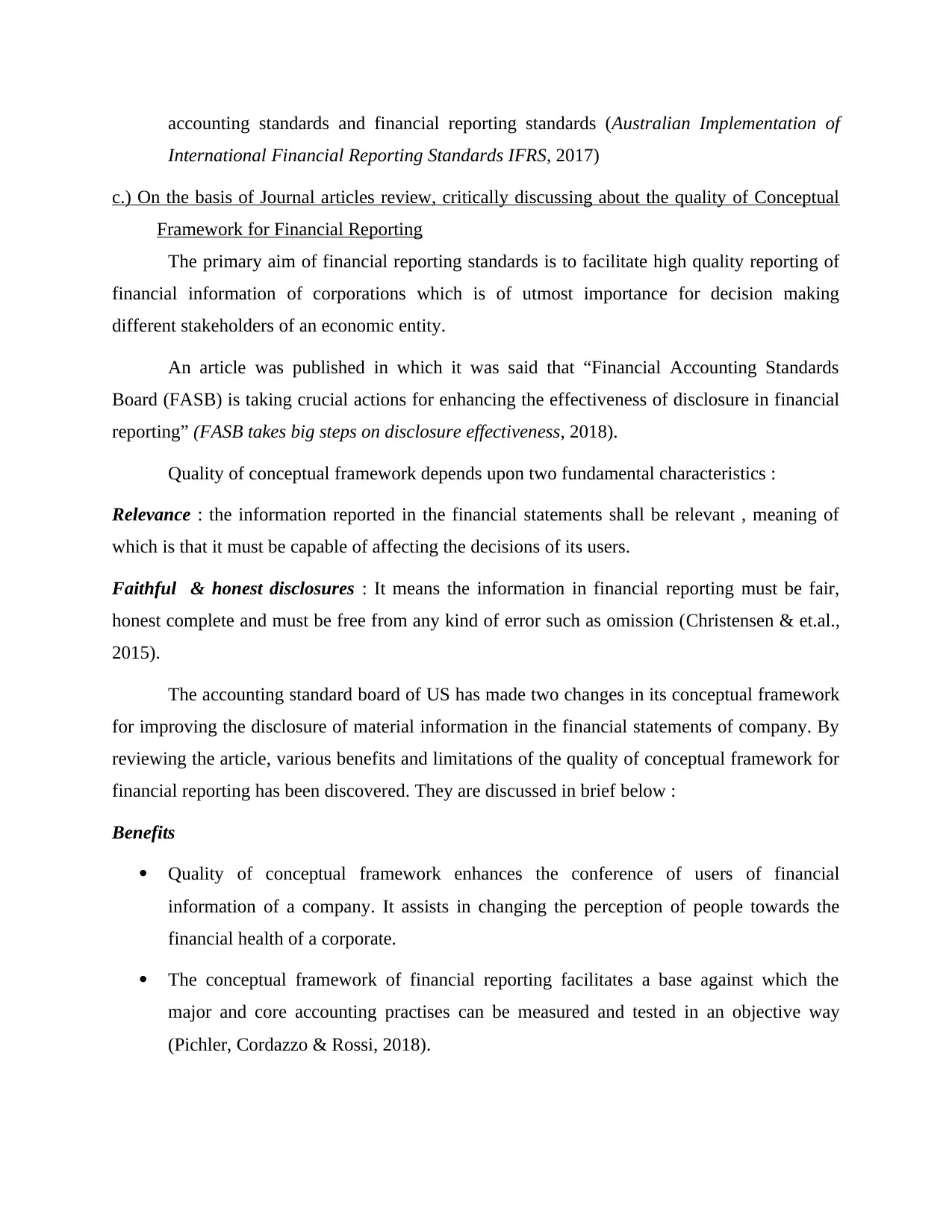
accounting standards and financial reporting standards (Australian Implementation of
International Financial Reporting Standards IFRS, 2017)
c.) On the basis of Journal articles review, critically discussing about the quality of Conceptual
Framework for Financial Reporting
The primary aim of financial reporting standards is to facilitate high quality reporting of
financial information of corporations which is of utmost importance for decision making
different stakeholders of an economic entity.
An article was published in which it was said that “Financial Accounting Standards
Board (FASB) is taking crucial actions for enhancing the effectiveness of disclosure in financial
reporting” (FASB takes big steps on disclosure effectiveness, 2018).
Quality of conceptual framework depends upon two fundamental characteristics :
Relevance : the information reported in the financial statements shall be relevant , meaning of
which is that it must be capable of affecting the decisions of its users.
Faithful & honest disclosures : It means the information in financial reporting must be fair,
honest complete and must be free from any kind of error such as omission (Christensen & et.al.,
2015).
The accounting standard board of US has made two changes in its conceptual framework
for improving the disclosure of material information in the financial statements of company. By
reviewing the article, various benefits and limitations of the quality of conceptual framework for
financial reporting has been discovered. They are discussed in brief below :
Benefits
Quality of conceptual framework enhances the conference of users of financial
information of a company. It assists in changing the perception of people towards the
financial health of a corporate.
The conceptual framework of financial reporting facilitates a base against which the
major and core accounting practises can be measured and tested in an objective way
(Pichler, Cordazzo & Rossi, 2018).
International Financial Reporting Standards IFRS, 2017)
c.) On the basis of Journal articles review, critically discussing about the quality of Conceptual
Framework for Financial Reporting
The primary aim of financial reporting standards is to facilitate high quality reporting of
financial information of corporations which is of utmost importance for decision making
different stakeholders of an economic entity.
An article was published in which it was said that “Financial Accounting Standards
Board (FASB) is taking crucial actions for enhancing the effectiveness of disclosure in financial
reporting” (FASB takes big steps on disclosure effectiveness, 2018).
Quality of conceptual framework depends upon two fundamental characteristics :
Relevance : the information reported in the financial statements shall be relevant , meaning of
which is that it must be capable of affecting the decisions of its users.
Faithful & honest disclosures : It means the information in financial reporting must be fair,
honest complete and must be free from any kind of error such as omission (Christensen & et.al.,
2015).
The accounting standard board of US has made two changes in its conceptual framework
for improving the disclosure of material information in the financial statements of company. By
reviewing the article, various benefits and limitations of the quality of conceptual framework for
financial reporting has been discovered. They are discussed in brief below :
Benefits
Quality of conceptual framework enhances the conference of users of financial
information of a company. It assists in changing the perception of people towards the
financial health of a corporate.
The conceptual framework of financial reporting facilitates a base against which the
major and core accounting practises can be measured and tested in an objective way
(Pichler, Cordazzo & Rossi, 2018).
Paraphrase This Document
Need a fresh take? Get an instant paraphrase of this document with our AI Paraphraser
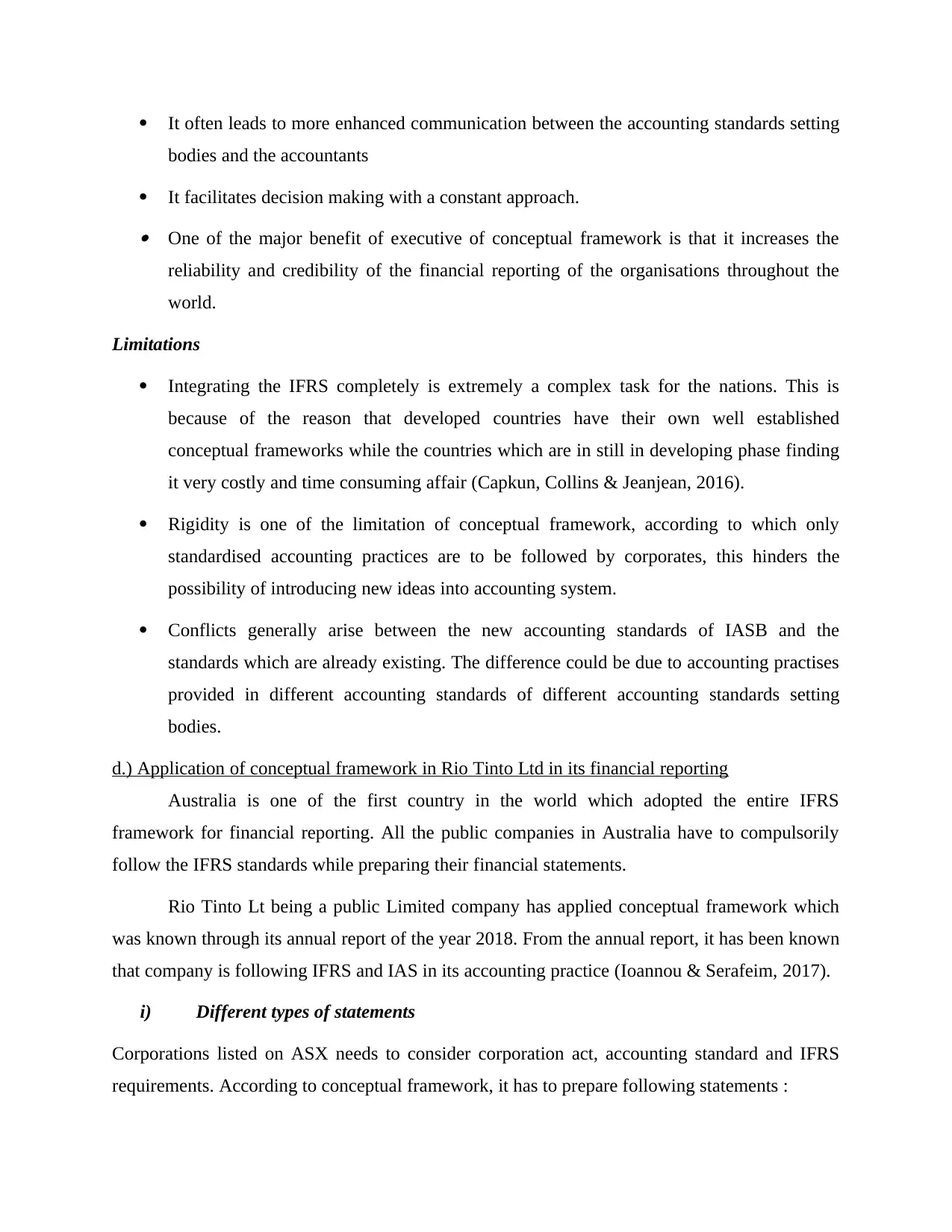
It often leads to more enhanced communication between the accounting standards setting
bodies and the accountants
It facilitates decision making with a constant approach. One of the major benefit of executive of conceptual framework is that it increases the
reliability and credibility of the financial reporting of the organisations throughout the
world.
Limitations
Integrating the IFRS completely is extremely a complex task for the nations. This is
because of the reason that developed countries have their own well established
conceptual frameworks while the countries which are in still in developing phase finding
it very costly and time consuming affair (Capkun, Collins & Jeanjean, 2016).
Rigidity is one of the limitation of conceptual framework, according to which only
standardised accounting practices are to be followed by corporates, this hinders the
possibility of introducing new ideas into accounting system.
Conflicts generally arise between the new accounting standards of IASB and the
standards which are already existing. The difference could be due to accounting practises
provided in different accounting standards of different accounting standards setting
bodies.
d.) Application of conceptual framework in Rio Tinto Ltd in its financial reporting
Australia is one of the first country in the world which adopted the entire IFRS
framework for financial reporting. All the public companies in Australia have to compulsorily
follow the IFRS standards while preparing their financial statements.
Rio Tinto Lt being a public Limited company has applied conceptual framework which
was known through its annual report of the year 2018. From the annual report, it has been known
that company is following IFRS and IAS in its accounting practice (Ioannou & Serafeim, 2017).
i) Different types of statements
Corporations listed on ASX needs to consider corporation act, accounting standard and IFRS
requirements. According to conceptual framework, it has to prepare following statements :
bodies and the accountants
It facilitates decision making with a constant approach. One of the major benefit of executive of conceptual framework is that it increases the
reliability and credibility of the financial reporting of the organisations throughout the
world.
Limitations
Integrating the IFRS completely is extremely a complex task for the nations. This is
because of the reason that developed countries have their own well established
conceptual frameworks while the countries which are in still in developing phase finding
it very costly and time consuming affair (Capkun, Collins & Jeanjean, 2016).
Rigidity is one of the limitation of conceptual framework, according to which only
standardised accounting practices are to be followed by corporates, this hinders the
possibility of introducing new ideas into accounting system.
Conflicts generally arise between the new accounting standards of IASB and the
standards which are already existing. The difference could be due to accounting practises
provided in different accounting standards of different accounting standards setting
bodies.
d.) Application of conceptual framework in Rio Tinto Ltd in its financial reporting
Australia is one of the first country in the world which adopted the entire IFRS
framework for financial reporting. All the public companies in Australia have to compulsorily
follow the IFRS standards while preparing their financial statements.
Rio Tinto Lt being a public Limited company has applied conceptual framework which
was known through its annual report of the year 2018. From the annual report, it has been known
that company is following IFRS and IAS in its accounting practice (Ioannou & Serafeim, 2017).
i) Different types of statements
Corporations listed on ASX needs to consider corporation act, accounting standard and IFRS
requirements. According to conceptual framework, it has to prepare following statements :
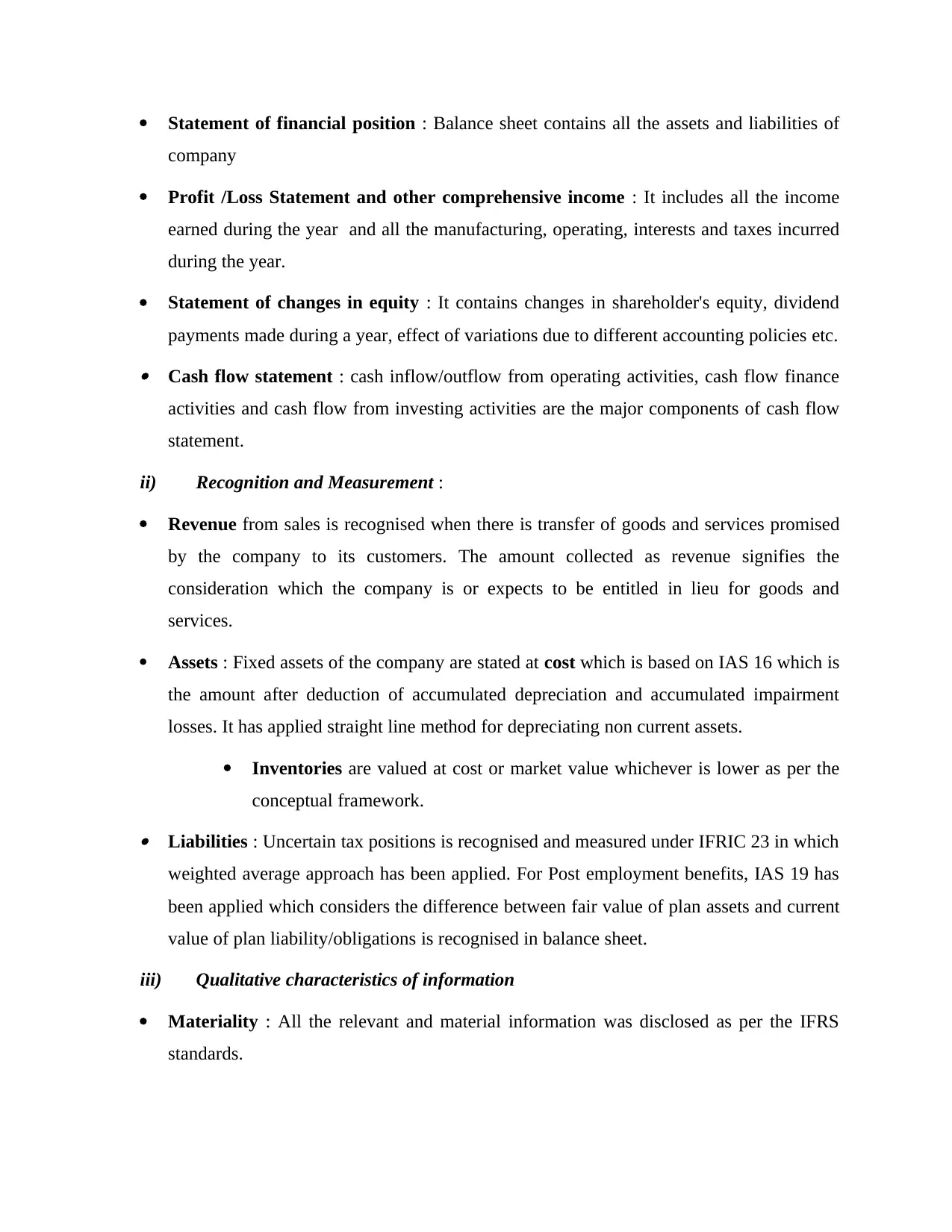
Statement of financial position : Balance sheet contains all the assets and liabilities of
company
Profit /Loss Statement and other comprehensive income : It includes all the income
earned during the year and all the manufacturing, operating, interests and taxes incurred
during the year.
Statement of changes in equity : It contains changes in shareholder's equity, dividend
payments made during a year, effect of variations due to different accounting policies etc. Cash flow statement : cash inflow/outflow from operating activities, cash flow finance
activities and cash flow from investing activities are the major components of cash flow
statement.
ii) Recognition and Measurement :
Revenue from sales is recognised when there is transfer of goods and services promised
by the company to its customers. The amount collected as revenue signifies the
consideration which the company is or expects to be entitled in lieu for goods and
services.
Assets : Fixed assets of the company are stated at cost which is based on IAS 16 which is
the amount after deduction of accumulated depreciation and accumulated impairment
losses. It has applied straight line method for depreciating non current assets.
Inventories are valued at cost or market value whichever is lower as per the
conceptual framework. Liabilities : Uncertain tax positions is recognised and measured under IFRIC 23 in which
weighted average approach has been applied. For Post employment benefits, IAS 19 has
been applied which considers the difference between fair value of plan assets and current
value of plan liability/obligations is recognised in balance sheet.
iii) Qualitative characteristics of information
Materiality : All the relevant and material information was disclosed as per the IFRS
standards.
company
Profit /Loss Statement and other comprehensive income : It includes all the income
earned during the year and all the manufacturing, operating, interests and taxes incurred
during the year.
Statement of changes in equity : It contains changes in shareholder's equity, dividend
payments made during a year, effect of variations due to different accounting policies etc. Cash flow statement : cash inflow/outflow from operating activities, cash flow finance
activities and cash flow from investing activities are the major components of cash flow
statement.
ii) Recognition and Measurement :
Revenue from sales is recognised when there is transfer of goods and services promised
by the company to its customers. The amount collected as revenue signifies the
consideration which the company is or expects to be entitled in lieu for goods and
services.
Assets : Fixed assets of the company are stated at cost which is based on IAS 16 which is
the amount after deduction of accumulated depreciation and accumulated impairment
losses. It has applied straight line method for depreciating non current assets.
Inventories are valued at cost or market value whichever is lower as per the
conceptual framework. Liabilities : Uncertain tax positions is recognised and measured under IFRIC 23 in which
weighted average approach has been applied. For Post employment benefits, IAS 19 has
been applied which considers the difference between fair value of plan assets and current
value of plan liability/obligations is recognised in balance sheet.
iii) Qualitative characteristics of information
Materiality : All the relevant and material information was disclosed as per the IFRS
standards.
⊘ This is a preview!⊘
Do you want full access?
Subscribe today to unlock all pages.

Trusted by 1+ million students worldwide
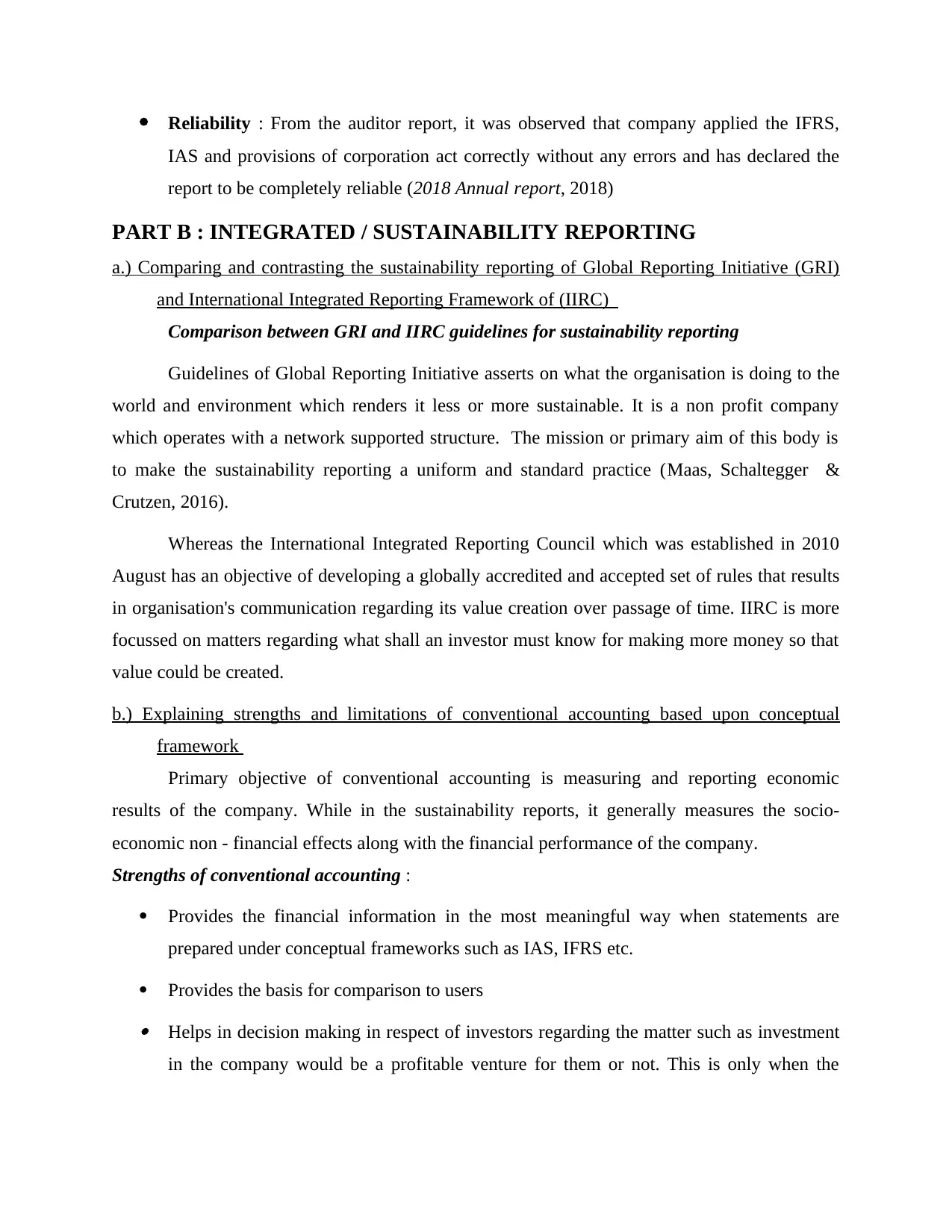
Reliability : From the auditor report, it was observed that company applied the IFRS,
IAS and provisions of corporation act correctly without any errors and has declared the
report to be completely reliable (2018 Annual report, 2018)
PART B : INTEGRATED / SUSTAINABILITY REPORTING
a.) Comparing and contrasting the sustainability reporting of Global Reporting Initiative (GRI)
and International Integrated Reporting Framework of (IIRC)
Comparison between GRI and IIRC guidelines for sustainability reporting
Guidelines of Global Reporting Initiative asserts on what the organisation is doing to the
world and environment which renders it less or more sustainable. It is a non profit company
which operates with a network supported structure. The mission or primary aim of this body is
to make the sustainability reporting a uniform and standard practice (Maas, Schaltegger &
Crutzen, 2016).
Whereas the International Integrated Reporting Council which was established in 2010
August has an objective of developing a globally accredited and accepted set of rules that results
in organisation's communication regarding its value creation over passage of time. IIRC is more
focussed on matters regarding what shall an investor must know for making more money so that
value could be created.
b.) Explaining strengths and limitations of conventional accounting based upon conceptual
framework
Primary objective of conventional accounting is measuring and reporting economic
results of the company. While in the sustainability reports, it generally measures the socio-
economic non - financial effects along with the financial performance of the company.
Strengths of conventional accounting :
Provides the financial information in the most meaningful way when statements are
prepared under conceptual frameworks such as IAS, IFRS etc.
Provides the basis for comparison to users Helps in decision making in respect of investors regarding the matter such as investment
in the company would be a profitable venture for them or not. This is only when the
IAS and provisions of corporation act correctly without any errors and has declared the
report to be completely reliable (2018 Annual report, 2018)
PART B : INTEGRATED / SUSTAINABILITY REPORTING
a.) Comparing and contrasting the sustainability reporting of Global Reporting Initiative (GRI)
and International Integrated Reporting Framework of (IIRC)
Comparison between GRI and IIRC guidelines for sustainability reporting
Guidelines of Global Reporting Initiative asserts on what the organisation is doing to the
world and environment which renders it less or more sustainable. It is a non profit company
which operates with a network supported structure. The mission or primary aim of this body is
to make the sustainability reporting a uniform and standard practice (Maas, Schaltegger &
Crutzen, 2016).
Whereas the International Integrated Reporting Council which was established in 2010
August has an objective of developing a globally accredited and accepted set of rules that results
in organisation's communication regarding its value creation over passage of time. IIRC is more
focussed on matters regarding what shall an investor must know for making more money so that
value could be created.
b.) Explaining strengths and limitations of conventional accounting based upon conceptual
framework
Primary objective of conventional accounting is measuring and reporting economic
results of the company. While in the sustainability reports, it generally measures the socio-
economic non - financial effects along with the financial performance of the company.
Strengths of conventional accounting :
Provides the financial information in the most meaningful way when statements are
prepared under conceptual frameworks such as IAS, IFRS etc.
Provides the basis for comparison to users Helps in decision making in respect of investors regarding the matter such as investment
in the company would be a profitable venture for them or not. This is only when the
Paraphrase This Document
Need a fresh take? Get an instant paraphrase of this document with our AI Paraphraser
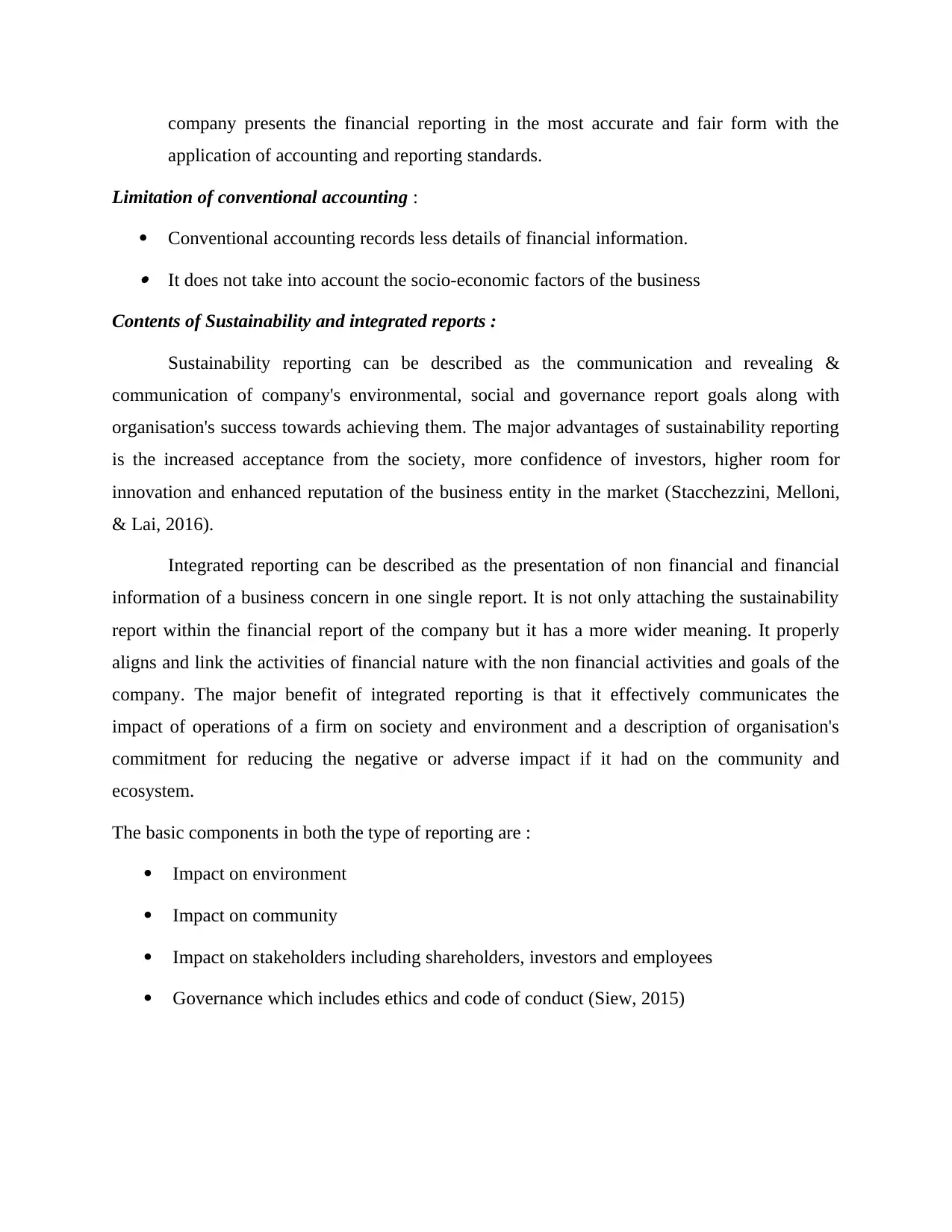
company presents the financial reporting in the most accurate and fair form with the
application of accounting and reporting standards.
Limitation of conventional accounting :
Conventional accounting records less details of financial information. It does not take into account the socio-economic factors of the business
Contents of Sustainability and integrated reports :
Sustainability reporting can be described as the communication and revealing &
communication of company's environmental, social and governance report goals along with
organisation's success towards achieving them. The major advantages of sustainability reporting
is the increased acceptance from the society, more confidence of investors, higher room for
innovation and enhanced reputation of the business entity in the market (Stacchezzini, Melloni,
& Lai, 2016).
Integrated reporting can be described as the presentation of non financial and financial
information of a business concern in one single report. It is not only attaching the sustainability
report within the financial report of the company but it has a more wider meaning. It properly
aligns and link the activities of financial nature with the non financial activities and goals of the
company. The major benefit of integrated reporting is that it effectively communicates the
impact of operations of a firm on society and environment and a description of organisation's
commitment for reducing the negative or adverse impact if it had on the community and
ecosystem.
The basic components in both the type of reporting are :
Impact on environment
Impact on community
Impact on stakeholders including shareholders, investors and employees
Governance which includes ethics and code of conduct (Siew, 2015)
application of accounting and reporting standards.
Limitation of conventional accounting :
Conventional accounting records less details of financial information. It does not take into account the socio-economic factors of the business
Contents of Sustainability and integrated reports :
Sustainability reporting can be described as the communication and revealing &
communication of company's environmental, social and governance report goals along with
organisation's success towards achieving them. The major advantages of sustainability reporting
is the increased acceptance from the society, more confidence of investors, higher room for
innovation and enhanced reputation of the business entity in the market (Stacchezzini, Melloni,
& Lai, 2016).
Integrated reporting can be described as the presentation of non financial and financial
information of a business concern in one single report. It is not only attaching the sustainability
report within the financial report of the company but it has a more wider meaning. It properly
aligns and link the activities of financial nature with the non financial activities and goals of the
company. The major benefit of integrated reporting is that it effectively communicates the
impact of operations of a firm on society and environment and a description of organisation's
commitment for reducing the negative or adverse impact if it had on the community and
ecosystem.
The basic components in both the type of reporting are :
Impact on environment
Impact on community
Impact on stakeholders including shareholders, investors and employees
Governance which includes ethics and code of conduct (Siew, 2015)
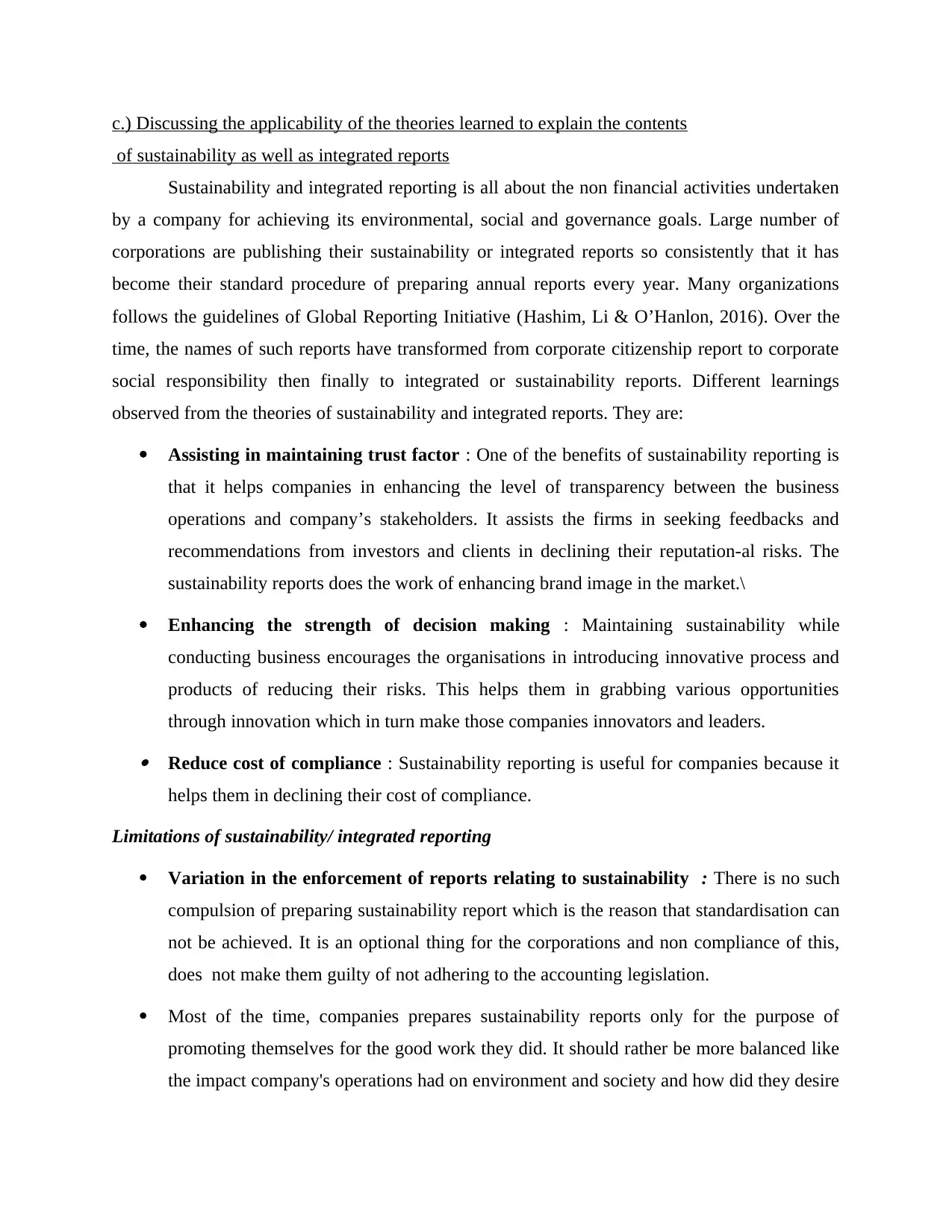
c.) Discussing the applicability of the theories learned to explain the contents
of sustainability as well as integrated reports
Sustainability and integrated reporting is all about the non financial activities undertaken
by a company for achieving its environmental, social and governance goals. Large number of
corporations are publishing their sustainability or integrated reports so consistently that it has
become their standard procedure of preparing annual reports every year. Many organizations
follows the guidelines of Global Reporting Initiative (Hashim, Li & O’Hanlon, 2016). Over the
time, the names of such reports have transformed from corporate citizenship report to corporate
social responsibility then finally to integrated or sustainability reports. Different learnings
observed from the theories of sustainability and integrated reports. They are:
Assisting in maintaining trust factor : One of the benefits of sustainability reporting is
that it helps companies in enhancing the level of transparency between the business
operations and company’s stakeholders. It assists the firms in seeking feedbacks and
recommendations from investors and clients in declining their reputation-al risks. The
sustainability reports does the work of enhancing brand image in the market.\
Enhancing the strength of decision making : Maintaining sustainability while
conducting business encourages the organisations in introducing innovative process and
products of reducing their risks. This helps them in grabbing various opportunities
through innovation which in turn make those companies innovators and leaders. Reduce cost of compliance : Sustainability reporting is useful for companies because it
helps them in declining their cost of compliance.
Limitations of sustainability/ integrated reporting
Variation in the enforcement of reports relating to sustainability : There is no such
compulsion of preparing sustainability report which is the reason that standardisation can
not be achieved. It is an optional thing for the corporations and non compliance of this,
does not make them guilty of not adhering to the accounting legislation.
Most of the time, companies prepares sustainability reports only for the purpose of
promoting themselves for the good work they did. It should rather be more balanced like
the impact company's operations had on environment and society and how did they desire
of sustainability as well as integrated reports
Sustainability and integrated reporting is all about the non financial activities undertaken
by a company for achieving its environmental, social and governance goals. Large number of
corporations are publishing their sustainability or integrated reports so consistently that it has
become their standard procedure of preparing annual reports every year. Many organizations
follows the guidelines of Global Reporting Initiative (Hashim, Li & O’Hanlon, 2016). Over the
time, the names of such reports have transformed from corporate citizenship report to corporate
social responsibility then finally to integrated or sustainability reports. Different learnings
observed from the theories of sustainability and integrated reports. They are:
Assisting in maintaining trust factor : One of the benefits of sustainability reporting is
that it helps companies in enhancing the level of transparency between the business
operations and company’s stakeholders. It assists the firms in seeking feedbacks and
recommendations from investors and clients in declining their reputation-al risks. The
sustainability reports does the work of enhancing brand image in the market.\
Enhancing the strength of decision making : Maintaining sustainability while
conducting business encourages the organisations in introducing innovative process and
products of reducing their risks. This helps them in grabbing various opportunities
through innovation which in turn make those companies innovators and leaders. Reduce cost of compliance : Sustainability reporting is useful for companies because it
helps them in declining their cost of compliance.
Limitations of sustainability/ integrated reporting
Variation in the enforcement of reports relating to sustainability : There is no such
compulsion of preparing sustainability report which is the reason that standardisation can
not be achieved. It is an optional thing for the corporations and non compliance of this,
does not make them guilty of not adhering to the accounting legislation.
Most of the time, companies prepares sustainability reports only for the purpose of
promoting themselves for the good work they did. It should rather be more balanced like
the impact company's operations had on environment and society and how did they desire
⊘ This is a preview!⊘
Do you want full access?
Subscribe today to unlock all pages.

Trusted by 1+ million students worldwide
1 out of 18
Related Documents
Your All-in-One AI-Powered Toolkit for Academic Success.
+13062052269
info@desklib.com
Available 24*7 on WhatsApp / Email
![[object Object]](/_next/static/media/star-bottom.7253800d.svg)
Unlock your academic potential
Copyright © 2020–2025 A2Z Services. All Rights Reserved. Developed and managed by ZUCOL.





